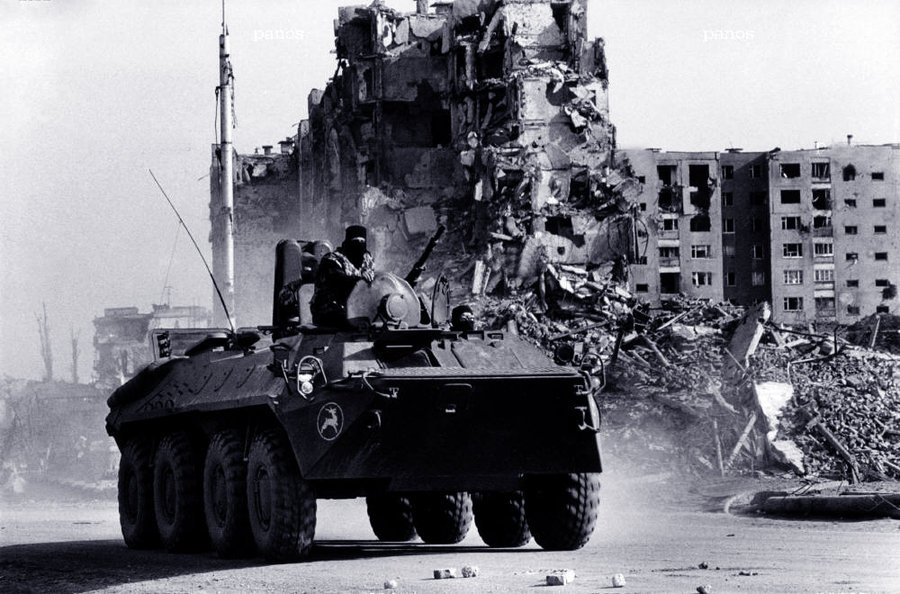The Islamic State and Chechnya: Disturbing Similarities
In
Log in if you are already registered

The active anti-terror operation that took place in Chechnya in 1999-2000 involved approximately 80,000 Russian troops and cost the Russian government billions of dollars to raise its economy from the ashes. By comparison, Chechnya is nearly ten times smaller than the area controlled by ISIS.
The Islamic State of Iraq and Syria went far beyond the operational scope of its predecessor, Al-Qaeda, establishing control over a large territory in northwestern Iraq and northeastern Syria, and creating proto-state institutions of authority. This reality is especially disturbing for the United States, which is bound by its Middle Eastern network of alliances to deter ISIS, but at the same time suffers from a twelve-year war-weariness and is not ready to conduct a full-scale counter-terrorist operation. Still, even more disturbing is the evidence of how similar the current instability in Iraq and Syria is with the bloody conflict in Chechnya, which troubled Russia for almost two decades and resulted in a 60,000 death toll.
First, both insurgency in Iraq and war in Chechnya originate from a similar political context. After the Soviet Union breakup, Moscow’s totalitarian control over the republics of Caucasus weakened, giving way to separatism, accompanied by ethnic and clannish rivalry. The defeat of federal forces in the First Chechen War (1994-1996) increased the rebel leaders’ self-assurance, and, three years later, numerous terrorist gangs invaded the neighboring Republic of Dagestan. In Iraq, the insurgency started soon after the international coalition’s victory over Saddam in 2003 and exacerbated after the American troops withdrawal in 2011. As Sami Zubaida argued, in Iraq it was the state that made the nation. Consequently, with Saddam’s state machine disruption, antagonism reemerged in the Sunni-Shia-Kurd triangle. Initially, the Sunni insurgency was a grass-roots opposition to outside invasion, which was converted into an internationalized terroristic group by al-Qaeda. In the same manner, the Chechen secessionists started up as a national liberation force, but later were entrapped by the international Islamist groups, primarily Saudi-sponsored Wahhabis. For instance, infamous Chechen warlord al-Khattab was a Saudi national who previously fought in Afghanistan and Tajikistan.
Second, in regard to the Saudi trace, it is important to mention that both Chechen fighters and ISIS received substantial funding from the Gulf monarchies. The only difference is that in the Chechen case the Saudi government did not have a direct interest in weakening Russia, and help was provided by individual Wahhabi supporters. As for Iraq, the Saudi officials explicitly announced the need for a “massive Saudi intervention” in order to protect the Sunni population from an alleged Shia aggression. However, Gulf monarchies’ sponsorship was not the only material incentive. Both ISIS and Chechen insurgents were making money by kidnapping foreigners, sacking businesses, and plundering oil from the pipelines and oilfields. In addition, ISIS and Chechen militants acquired their weapons from the captured military warehouses, namely army reserves in Russia, and the supplies for pro-American militia “Sons of Iraq.”
Third, the Chechen and Islamist insurgents used the same tactics. Both started fighting in small groups, disturbing their enemies by hit-and-run raids, but proceeded to a full-scale action once they became stronger. Psychological warfare is also similar: beheadings on-camera, demonstrated reprisals against dissidents, and threats of terrorist attacks. However, ISIS made two steps forward in promoting its brand and ideology through the social media.
The last common trait of ISIS and the Chechen rebels is their attitude towards the other Muslims. Despite the proclamation of Caliphate and pretention for a universal Islamic rule, ISIS is actually hostile towards all of its neighbors, including Iraqi Shias and Kurds, Iran, and, surprisingly, Saudi Arabia, as ISIS officials announced their intention to attack Mecca and destroy Kaaba. No competent Muslim politician, cleric or scholar would recognize the Islamic State, just as no one recognized the self-proclaimed Chechen republic in 1990s. Although the Chechen leaders proclaimed a virtual state of “Caucasus emirate,” no real Muslim unity existed in the Northern Caucasus. The Chechen republic repeatedly attacked the neighboring Ingushetia and Dagestan, Muslim-dominated republics of the Russian Federation, and its fighters committed several episodes of ethnic cleansing against non-Chechen Muslims. The truth is, in both ISIS and independent Chechnya the Islamist ideology has very little in common with the real Islam, and has been used by the warlords as an excuse for their atrocities and plunder.
The big question
How much will it cost to defeat ISIS, and who is going to pay? The Chechen rebellion was an exclusively Russian problem, although eventually Russian power was enough to defeat it. ISIS has a similar origin, tactics, and source of finance, but its neighbors are relatively weak, and only a long-term involvement of a great power can bring ISIS’ demise. The active anti-terror operation in 1999-2000 involved approximately 80,000 Russian troops and cost the Russian government billions of dollars to raise the Chechen economy from the ashes. By comparison, Chechnya is nearly ten times smaller than the area controlled by ISIS.
Although the United States and its allies support the government in Baghdad and the Kurdish militia Peshmerga with weapons and air strikes, this force is barely enough to hold the field against a daily growing enemy, hardened in previous insurgency wars in Afghanistan, Pakistan and Chechnya. Irrevocable defeat of ISIS requires an intervention by a professionally organized and well-equipped army, capable of securing ISIS-infiltrated settlements, achieving military victory, and staying in the country long enough to reconstruct the state institutions. In post-Saddam Iraq, this mission took eight years and was interrupted by a mistaken disengagement. In reintegrated Chechnya, the counter-terrorist operation regime lasted for more than nine years. The same degree of perseverance will be needed in the post-ISIS Iraq. Again, the only power capable of such a mission is the United States. Therefore, I agree with Ryan Crocker, a former U.S. Ambassador to Iraq, that the United States should forcefully reengage with Iraq before it is too late. ISIS has already become a force more formidable than the Chechen rebellion in 1990s. Absence of adequate response from the United States and its allies will result in a belt of chaos in the Middle East, thousands of deaths, and unpredictable changes at the world oil market.




